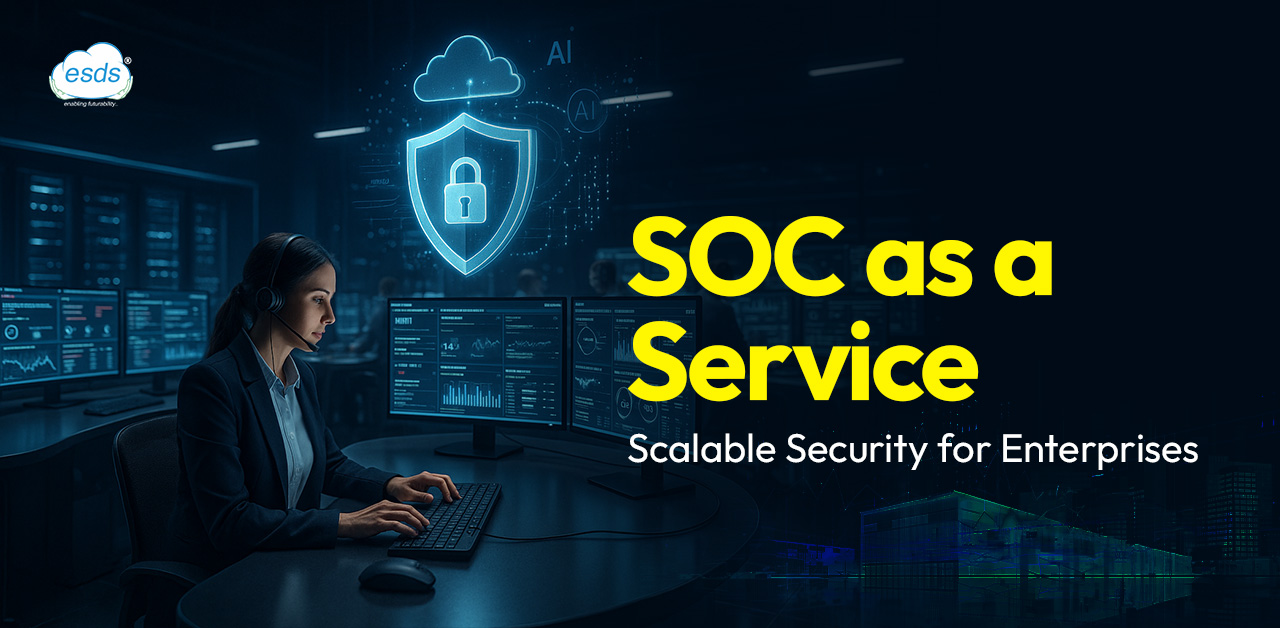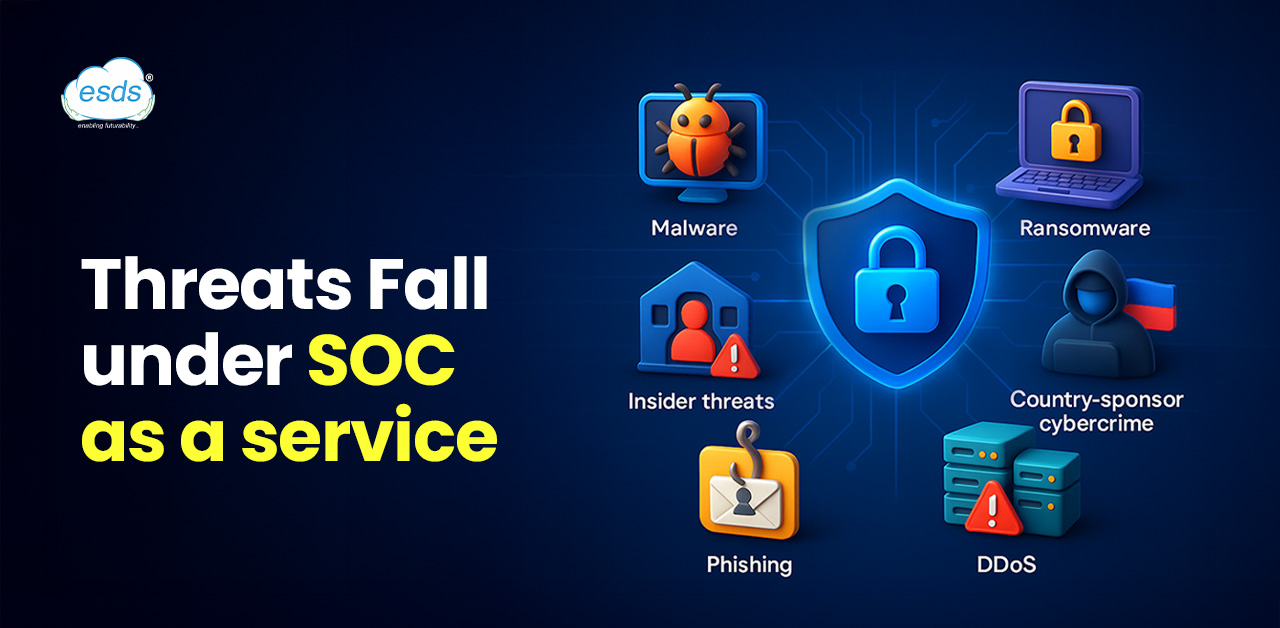SOC as a Service Enabling Best Security for Smarter Enterprises

As digital adoption accelerates and hybrid work becomes the norm, businesses are more vulnerable than ever. SOC as a Service is emerging as a vital solution to address these growing cybersecurity threats efficiently and affordably. According to an IMF report, cybercrime is project to cost the world $23 trillion by 2027 – a 175% increase from 2022. From phishing to DDoS attacks, the threat landscape is evolving rapidly.
A key weapon in defending against these threats is the Security Operations Center (SOC). But building an in-house SOC can be costly and complex especially with the global cybersecurity talent shortage. That’s why businesses are turning to SOC as a Service for scalable, expert-led protection.
In this blog, you will understand what SOC as Service really means, why it’s becoming essential for modern enterprises, how it can strengthen your cybersecurity posture without the overhead of an in-house SOC.
What Is SOC as a Service & How It Works
Without having to hire a team of security experts or pay out thousands of dollars for tools, Security Operations Center as a Service is a cloud-based subscription model that gives organizations a plug-and-play command center to build and improve their cybersecurity posture or fill any gaps in their current posture. Business settings with limited resources (money, skill pool) are ideal for SOC as a Service. Early-stage businesses frequently struggle to justify the substantial expenditure required to build an effective cybersecurity posture from the bottom up.
SOC as a Service serves as an operational hub that enables businesses to see their business environment, spot vulnerabilities, strengthen areas, keep an eye on security alerts, and enhance their overall security posture.
Below is the representation of the working of SOC as a Service: –
Security Operations Center Tools + Team of Cybersecurity professionals = SOC as a Service
How does SOC as a Service apply to your
business?
SOC as a Service is a ground-breaking solution that provides the newest security solutions with the best defense while reducing the amount of money you spend on security-related operations.
According to a recent Forbes study, at least one company worldwide is impacted by a cyberattack every 39 seconds.
This implies that at least one hacker has successfully compromised a company system and gained access to intellectual property somewhere in the world during the time you spent learning about SOC as a Service today. Companies need to figure out how to put scale ahead of security.
What kinds of threats fall under SOC as a Service?
Using a range of tech stacks to uncover vulnerabilities in real-time, apply artificial intelligence (AI) to spot trends, and forecast potential threats, attack sources, and their potential effects on your company are all common SOC leverages. Although these are the most popular service options, SOC also provides tens of hundreds of supplementary services.
The extent of your subscription is up to you as a SOC as a Service subscriber. Depending on the SOC as a Service provider you use, you may occasionally be able to obtain a customized security solution. It’s crucial to understand that SOC as a Service has drawbacks. They are not infallible, even if they are made to get better all the time. The dangers of the future do not exempt them.
Key Threat Vectors Mitigated by SOC as a Service
Nevertheless, SOC as a Service has demonstrated remarkable defenses against several breach vectors, some of which we have mentioned here:

- Malware
Malware is complex software that can damage your system just by listening to data entering and leaving. It will seriously harm your system by infecting it to launch the attacker’s application.
- Phishing
Another type of cyberattack is phishing, which starts with a phony email or other communication getting into your system. This threat’s primary objective is to trick you, the victim, into clicking on a dangerous link.
- Insider threats
Although it comes as a surprise, this is a common hazard to businesses. People who wish to see you fail can occasionally be found right in front of you. An insider threat is a serious security danger that comes from within your organization, such as from your employees.
- Ransomware
Another type of malware is ransomware, which is mostly intended to prevent a user or orgaization from accessing files on their own system. The intriguing aspect of these sophisticated threats is that the money to gain access is almostimpossible to track down, and attackers have become infamously inventive over time.
- DDOS
OpenAI has acknowledged that they were battling a slew of DDoS attacks. Several traffic patterns caused occasional disruptions as a result. DDoS will bring down your network and make it more difficult for users to access the platform. In the end, it causes the system to crash. Millions of customers were prevented from using the software as intended, and fixing it most likely lost the company money and reputation.
- Country than sponsor cybercrimes
Some nations encourage cybercrime, which increases the likelihood that illicit online activity will flourish there.
Key Roles in a Managed SOC Team
With a variety of technological investments, managed SOC as a Service plays a number of functions and tasks that support maintaining your security posture.
Among this service’s duties and tasks are:
- Delegating authority to determine which services within the larger security package are pertinent to them.
- Examine and address any online dangers.
- Transform the intricacies of cyberthreats or consequences into plain language that any stakeholder or layperson can understand.
Regarding the function of a SOC as a Service, you must now determine who will be on the team to handle security issues as you choose your vendor. They are:
| Roles | Responsibilities |
| SOC Manager | Lead the SOC teams and over all security operations monitoring. |
| Security Analyst Tier – 1 | Monitors alerts and identifying potential incidents |
| Security Analyst Tier – 2 | Handles serious alerts & initiates immediate actions. |
| Security Analyst Tier -3 | Investigate advanced threats and uncovers how breaches occurred. |
| Compliance Auditor | Ensures compliance with regulations and policy. |
| Security Architect | Design & implement security system. |
| SOC Co-ordinator | Bridges communication between SOC vendor & internal teams. |
Top 4 SOC as a Service Benefits
- Continuous Monitoring
SOC guards are among the few that are ready around-the-clock to defend and safeguard the company’s business environment against cyberattacks. By continuously examining records to identify irregularities through ongoing monitoring, they are continually on the lookout for anything that can be harmful, much like a guard on duty.
- Immediate response
SOCs require a lot less time to identify risks and implement remediation techniques since they are constantly alert for them. When they identify a vulnerability in real-time, they evaluate its characteristics to rule out false positives, gauge the threat it poses, and designate its severity.
- Prevent threats
Patching threats and vulnerabilities is only one aspect of SOCs. Additionally, they actively work to enhance the organization’s current infrastructure and security procedures in order to stay ahead of hackers and their methods of entry.
- Training
The team is in charge of educating their immediate team members about the most recent security landscape misses and hits. In addition, they run training programs to teach staff members about the latest penetration models and how to stop them from happening.
Must Read: SOAR vs Traditional SOC: A Comparative Guide
What Next?
All things considered, SOC as a Service is a crucial control center for your business’s defense against cybersecurity attacks. Possessing robust security solutions and full visibility into your corporate environment strengthens your security assessment posture.
ESDS Managed SOC Services: A tool that detects, prevents, investigates and responds to cyber threats. Provides a secure and scalable environment for cybersecurity operations. It also ensures remote access to business data and IT resources. It continuously monitors, and provides backup protection to prevent ransomware attacks.
Secure your digital future. Contact us to discover how our SOC as a Service can protect your business.
- 10 Ways to Reduce GPU Cloud Spend and Get Better Performance - December 17, 2025
- Sovereign AI Infrastructure Blueprint: How to Build It Right - December 15, 2025
- Private vs Public Cloud: Which Is More Compliant in India? - December 11, 2025
